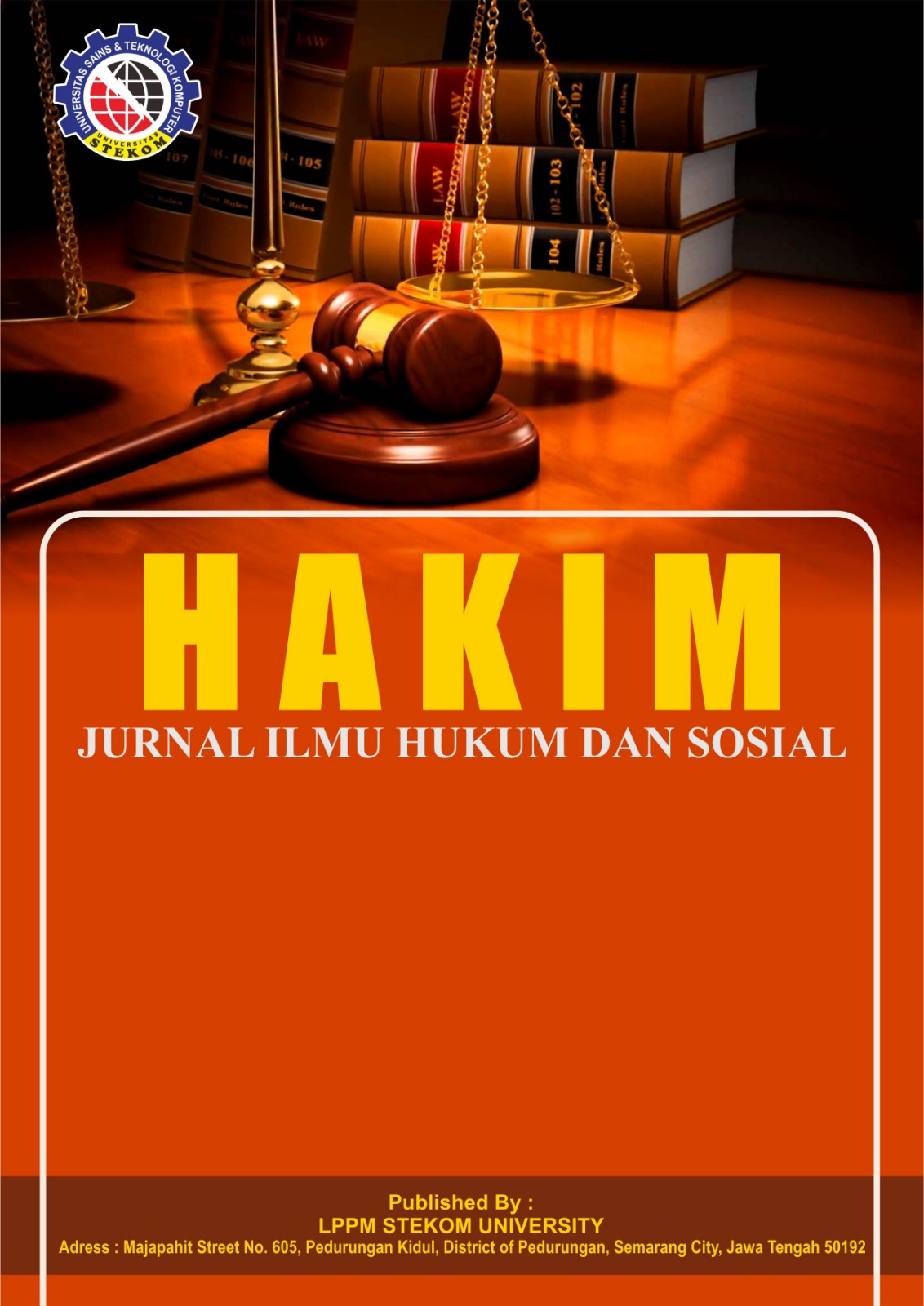Cyberbullying and Legal Protection for Victims in the Digital Era: A Case Study on Social Media Platforms
DOI:
https://doi.org/10.51903/hakim.v3i1.2290Keywords:
Cyberbullying, Legal Protection, UU ITE, Social Media, Law EnforcementAbstract
In the digital era, the widespread use of social media has led to a significant rise in cyberbullying cases, which have severe psychological, social, and legal consequences for victims. In Indonesia, the Electronic Information and Transactions Law (UU ITE) regulates cyberbullying; however, its implementation faces numerous challenges. This study aims to analyze the effectiveness of legal protection for cyberbullying victims in Indonesia and identify the challenges in enforcing existing regulations. Employing a juridical approach with qualitative analysis, this research examines relevant legal frameworks and conducts interviews with victims, legal practitioners, and law enforcement officials. Additionally, secondary data from official reports and court decisions are analyzed to understand the enforcement patterns of cyberbullying cases. Findings indicate that reported cyberbullying cases increased from 800 in 2018 to 3,800 in 2023, with the majority occurring on platforms such as TikTok and Instagram. However, only 20% of these reports were acted upon by authorities, and merely 5% resulted in legal consequences for perpetrators. Key obstacles in law enforcement include difficulties in identifying perpetrators using anonymous identities, lack of coordination between social media platforms and law enforcement agencies, and low public awareness regarding reporting mechanisms. This study contributes to policy recommendations aimed at strengthening legal protection for cyberbullying victims. These include regulatory reforms, increased digital literacy initiatives, and the optimization of technology in mitigating cyberbullying in Indonesia
References
Ali, S. I., & Shahbuddin, N. B. (2022). The Relationship between Cyberbullying and Mental Health among University Students. Sustainability (Switzerland), 14(11), 1–14. https://doi.org/10.3390/su14116881
Althibyani, H. A., & Al-Zahrani, A. M. (2023). Investigating the Effect of Students’ Knowledge, Beliefs, and Digital Citizenship Skills on the Prevention of Cybercrime. Sustainability, 15(15), 11512. https://doi.org/10.3390/su151511512
Arkhan, M., Bastian, M., Sutanto, R., Basuni, R. R., & Korespondensi, P. (2025). Evaluasi Efektivitas Undang-Undang No. 1 Tahun 2024 Tentang Informasi dan Transaksi Elektronik dalam Pencegahan Cyberterrorism. Jurnal Hukum Mimbar Justitia, 10(2), 430–443. https://doi.org/10.35194/jhmj.v10i2.4997
Bernik, I., Prislan, K., & Mihelič, A. (2022). Country Life in the Digital Era: Comparison of Technology Use and Cybercrime Victimization between Residents of Rural and Urban Environments in Slovenia. Sustainability, 14(21), 14487. https://doi.org/10.3390/su142114487
Canestrari, C., Arroyo, G. D. M., Carrieri, A., Muzi, M., & Fermani, A. (2023). Parental Attachment and Cyberbullying Victims: The Mediation Effect of Gelotophobia. Current Psychology, 42(19), 16401–16412. https://doi.org/10.1007/s12144-021-01642-6
Chun, J. S., Kim, J., & Lee, S. (2023). A Content Analysis of South Korean Newspaper Coverage of Adolescent Cyberbullying. Children & Society, 37(6), 2011–2029. https://doi.org/10.1111/chso.12695
Farrington, D. P., Zych, I., Ttofi, M. M., & Gaffney, H. (2023). Cyberbullying Research in Canada: A Systematic Review of the First 100 Empirical Studies. Aggression and Violent Behavior, 69, 101811. https://doi.org/10.1016/j.avb.2022.101811
Gongane, V. U., Munot, M. V., & Anuse, A. D. (2022). Detection and Moderation of Detrimental Content on Social Media Platforms: Current Status and Future Directions. In Social Network Analysis and Mining (Vol. 12, Issue 1). Springer Vienna. https://doi.org/10.1007/s13278-022-00951-3
Halliday, S., Taylor, A., Turnbull, D., & Gregory, T. (2024). The Relationship Between Traditional and Cyber Bullying Victimization in Early Adolescence and Emotional Wellbeing: A Cross-Sectional, Population-Based Study. International Journal of Bullying Prevention, 6(2), 110–123. https://doi.org/10.1007/s42380-022-00144-8
Hasan, M. M., Fatima, Y., Cleary, A., McDaid, L., Munir, K., Smith, S. S., Dias, S., Baxter, J., & Mamun, A. (2023). Geographical Variations in the Prevalence of Traditional and Cyberbullying and Its Additive Role in Psychological and Somatic Health Complaints Among Adolescents in 38 European Countries. Journal of Psychosomatic Research, 164, 111103. https://doi.org/10.1016/j.jpsychores.2022.111103
Hendry, B. P., Hellsten, L. ann M., McIntyre, L. J., & Smith, B. R. R. (2023). Recommendations for Cyberbullying Prevention and Intervention: A Western Canadian Perspective from Key Stakeholders. Frontiers in Psychology, 14, 1–10. https://doi.org/10.3389/fpsyg.2023.1067484
Ifon, J. C. (2023). Management of Cyberbullying: A Qualitative Exploratory Case Study of a Nigerian University. International Journal of Bullying Prevention, 5(2), 161–177. https://doi.org/10.1007/s42380-022-00124-y
Izzah, N., Mahdi, M. A., Julkarnain, D., Rato, D., & Ohoiwutun. (2024). Perlindungan Hukum Terhadap Pemberdayaan Informasi dari Ancaman Buzzer: Konsepsi Pembatasan Akun Media Sosial. Jurnal ISO: Jurnal Ilmu Sosial, Politik Dan Humaniora, 4(2), 12–12. https://doi.org/10.53697/iso.v4i2.1908
Kaur, M., & Saini, M. (2023). Indian Government Initiatives on Cyberbullying: A Case Study on Cyberbullying in Indian Higher Education Institutions. In Education and Information Technologies (Vol. 28, Issue 1). Springer US. https://doi.org/10.1007/s10639-022-11168-4
Kharisma, D. B., & Hunaifa, A. (2023). Comparative Study of Disgorgement and Disgorgement Fund Regulations in Indonesia, The USA and The UK. Journal of Financial Crime, 30(3), 635–649. https://doi.org/10.1108/jfc-01-2022-0022
Kumar, R., & Bhat, A. (2022). A Study of Machine Learning-Based Models for Detection, Control, and Mitigation of Cyberbullying in Online Social Media. International Journal of Information Security, 21(6), 1409–1431. https://doi.org/10.1007/s10207-022-00600-y
Lan, M., Law, N., & Pan, Q. (2022). Effectiveness of Anti-Cyberbullying Educational Programs: A Socio-Ecologically Grounded Systematic Review and Meta-Analysis. Computers in Human Behavior, 130, 107200. https://doi.org/10.1016/j.chb.2022.107200
Li, C., Wang, P., Martin-Moratinos, M., Bella-Fernández, M., & Blasco-Fontecilla, H. (2022). Traditional Bullying and Cyberbullying in the Digital Age and Its Associated Mental Health Problems in Children and Adolescents: A Meta-Analysis. European Child and Adolescent Psychiatry, 33(9), 2895–2909. https://doi.org/10.1007/s00787-022-02128-x
Lin, J. W., & Shorey, S. (2023). Online Peer Support Communities in the Infertility Journey: A Systematic Mixed-Studies Review. International Journal of Nursing Studies, 140, 104454. https://doi.org/10.1016/j.ijnurstu.2023.104454
Mishra, A., Alzoubi, Y. I., Anwar, M. J., & Gill, A. Q. (2022). Attributes Impacting Cybersecurity Policy Development: An Evidence from Seven Nations. Computers and Security, 120, 102820. https://doi.org/10.1016/j.cose.2022.102820
Monsees, L., & Lambach, D. (2022). Digital Sovereignty, Geopolitical Imaginaries, and the Reproduction of European Identity. European Security, 31(3), 377–394. https://doi.org/10.1080/09662839.2022.2101883
Nisa, A., Nisa, M., Taun, T., HSRonggo Waluyo, J., Timur, T., & Barat, J. (2024). Tindakan Cyberbullying Di Media Sosial Hukum Dan Masyarakat. Hakim: Jurnal Ilmu Hukum Dan Sosial, 2(1), 299–305. https://doi.org/10.51903/hakim.v2i1.1571
Niu, J., Mazhar, B., Haq, I. U., & Maqsood, F. (2024). Protecting Privacy on Social Media: Mitigating Cyberbullying and Data Heist Through Regulated Use and Detox, with a Mediating Role of Privacy Safety Motivations. Social Media and Society, 10(4), 1–16. https://doi.org/10.1177/20563051241306331
Ramadan, O. M. E., Alruwaili, M. M., Alruwaili, A. N., Elsharkawy, N. B., Abdelaziz, E. M., El Badawy Ezzat, R. E. S., & El-Nasr, E. M. S. (2024). Digital Dilemma of Cyberbullying Victimization among High School Students: Prevalence, Risk Factors, and Associations with Stress and Mental Well-Being. Children, 11(6), 634. https://doi.org/10.3390/children11060634
Schultze-Krumbholz, A., Pfetsch, J. S., & Lietz, K. (2022). Cyberbullying in a Multicultural Context—Forms, Strain, and Coping Related to Ethnicity-Based Cybervictimization. Frontiers in Communication, 7, 1–13. https://doi.org/10.3389/fcomm.2022.846794
Serpa, S., Sá, M. J., Siddiqui, S., & Schultze-Krumbholz, A. (2023). Successful and Emerging Cyberbullying Prevention Programs: A Narrative Review of Seventeen Interventions Applied Worldwide. Societies, 13(9), 212. https://doi.org/10.3390/soc13090212
Sorrentino, A., Sulla, F., Santamato, M., Cipriano, A., & Cella, S. (2023). The Long-Term Efficacy and Sustainability of the Tabby Improved Prevention and Intervention Program in Reducing Cyberbullying and Cybervictimization. International Journal of Environmental Research and Public Health, 20(8), 5436. https://doi.org/10.3390/ijerph20085436
Tintori, A., Ciancimino, G., & Cerbara, L. (2025). Sociopsychological Analysis of a Highly Vulnerable Category of Adolescents: Victim-Perpetrators of Cyberbullying from a Wide National Survey of Italian Adolescents. Societies, 15(2), 25. https://doi.org/10.3390/soc15020025
Zhao, L., Wu, Y., Huang, X., & Zhang, L. (2022). Network Anonymity and Cyberbullying among Chinese Adolescents: A Moderated Mediation Model. International Journal of Environmental Research and Public Health, 19(2), 637. https://doi.org/10.3390/ijerph19020637











3.png)
